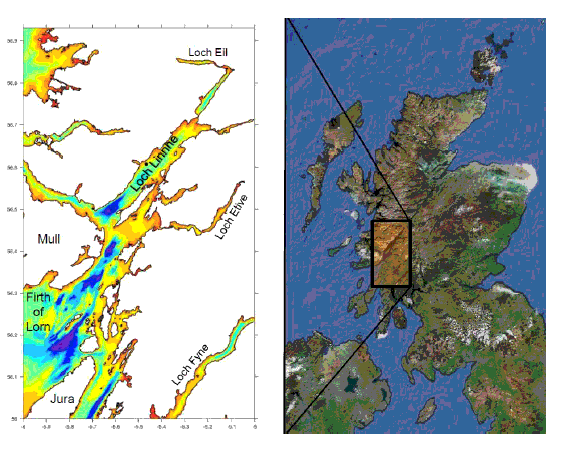Scottish Marine and Freshwater Science Volume 6 Number 1: Loch Linnhe and Firth of Lorn MASTS Case Study Workshop Report
Report on a case study workshop on the Loch Linnhe and Firth of Lorn (LL&FL) system.
DOI: 10.7489/1539-1
Introduction
Loch Linnhe is one of the largest sea lochs on Scotland's west coast, stretching approximately 60 km in a SW- NE direction. The loch receives large freshwater inputs from the surrounding catchments and connects to the open ocean at the SW end via the Sound of Mull and Firth of Lorn (Figure 1). The loch itself can be regarded as having a fjordic character where interactions between meteorological forcing, freshwater input and sea bed topography control the circulation.

Figure 1: Map of Loch Linnhe and the Firth of Lorn (courtesy of A. Dale, SAMS).
Over the past decades, the region has been the object of a number of research and observational programs by the marine research community. This interest has been driven in more recent years by research around aquaculture, with studies focusing on sea lice dispersal management ( Salama et al., 2013; Salama & Rabe, 2013), plankton ecology ( Heath, 1995) and relevant numerical modelling. Only a limited number of papers have reported on the physical oceanography of the region ( Allen & Simpson, 1998a, 1998b). The region is, however, relatively data rich with several studies having collected time series observations of circulation, temperature and salinity. To date, most analyses have focused on the upper loch, rather than the more complex system including the main and other side lochs. Hydrodynamic modelling of the system has also been pursued by a number of researchers and is currently an area of active development. However, the existing scientific literature still lacks a complete review of the dynamics and variability of Loch Linnhe and the Firth of Lorn.
From a stakeholder perspective, flood forecasting and aquaculture-related topics remain of high importance but wider issues relating to marine spatial planning are moving up the agenda. In the context of new research developments, now is an ideal time to consider an integration of knowledge across all research fields: from physical oceanography to water quality and biology. The Scottish Government supports industry led targets for the expansion of finfish and shellfish aquaculture across the country. It is, therefore, likely that the assessment of aquaculture potential and marine planning in the region will become important drivers for research.
On 25-26 February 2014, members of MASTS's DPMS Research Theme attended a workshop in Crieff to review our current knowledge of the LL& FL system and discuss areas of research required to address the challenges mentioned above. Although originally focussed on Loch Linnhe, it was decided to expand the spatial coverage of the workshop to include the Firth of Lorn because of the linkages between the two systems, the fact that considerable data also exist for the Firth of Lorn and because of the interests of the workshop participants.
This report will provide an overview of these discussions. The agenda of the meeting and list of attendees have been included in Appendix 1 and 2, respectively. An overview of related websites and literature published as peer-review manuscripts and internal reports is included in Appendix 3.
Contact
There is a problem
Thanks for your feedback